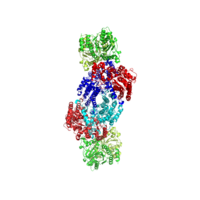
Photo from wikipedia
In bimetallic heterostructured nanoparticles (NPs), the synergistic effect between their different metallic components leads to higher catalytic activity compared to the activity of the individual components. However, how the dynamic… Click to show full abstract
In bimetallic heterostructured nanoparticles (NPs), the synergistic effect between their different metallic components leads to higher catalytic activity compared to the activity of the individual components. However, how the dynamic changes through which these NPs adopt catalytically active structures during a reaction and how the restructuring affects their activity are largely unknown. Here, using operando transmission electron microscopy, structural changes are studied in bimetallic Ni–Rh NPs, comprising of a Ni core whose surface is decorated with smaller Rh NPs, during a CO oxidation reaction. The direct atomic‐scale imaging reveals that, under O2‐rich conditions, Ni core partially transforms into NiO, forming a (Ni+NiO)–Rh hollow nanocatalyst with high catalytic activity. Under O2‐poor conditions, Rh NPs alloy with the surface of the core to form a NiRh‐alloy surface, and the NPs display significantly lower activity. The theoretical calculations indicate that NiO component that forms only under O2‐rich conditions enhances the activity by preventing the CO poisoning of the nanocatalysts. The results demonstrate that visualizing the structural changes during reactions is indispensable in identifying the origin of catalytic activity. These insights into the dynamic restructuring of NP catalysts under a reactive environment are critical for the rational design of high‐performance nanocatalysts.
Journal Title: Advanced Science
Year Published: 2022
Link to full text (if available)
Share on Social Media: Sign Up to like & get
recommendations!